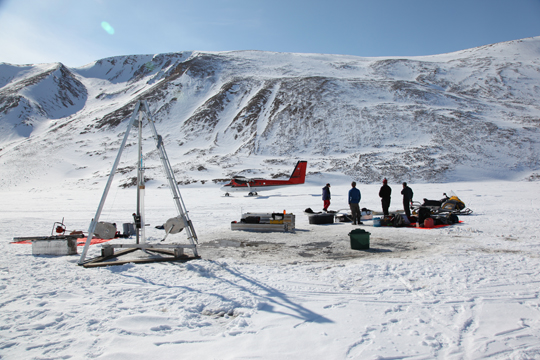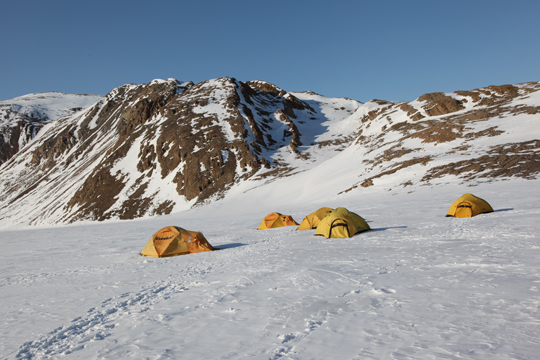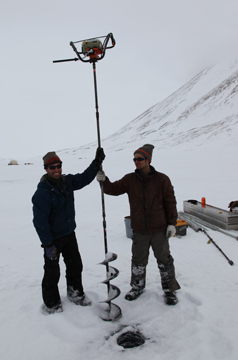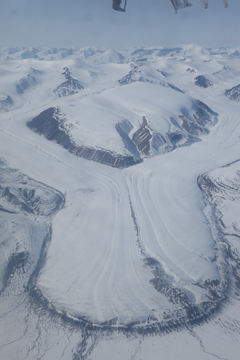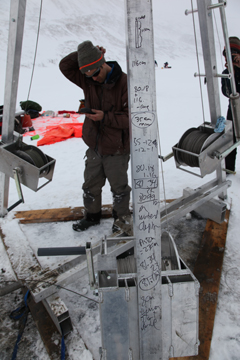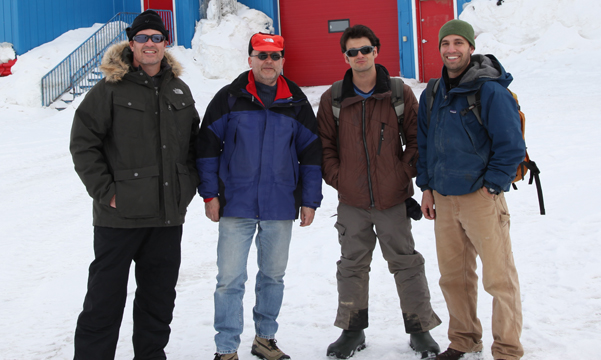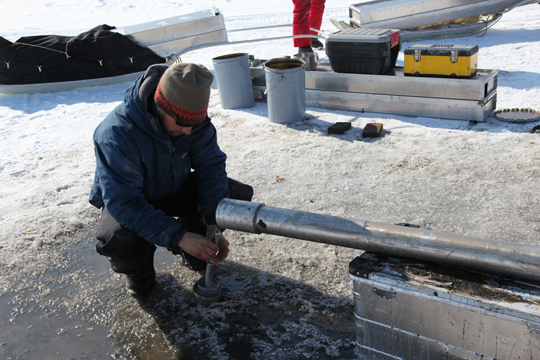 |
||||||||||||||
|
|
||||||||||||||
|
Ellesmere Island
|
|
Improving Our Understanding of Holocene Climate and Paleomagnetism in the High Arctic, Ellesmere Island, Canada - Collaborators include Joe Stoner, Ray Bradley, Pierre Francus, Ted Lewis, Carsten Braun, Sheldon Smith, Nick Balascio, and Rob Hatfield among others Historical and recent paleomagnetic observations, along with geodynamo modeling studies highlight the importance of non-axisymmetric flux concentrations, not only as an indicator that the mantle has an important influence on the geodynamo, but also that it may act as a potential organizing structure that might control much of the dynamics of the geomagnetic field including paleomagnetic secular variation (PSV). Comparison of specific, well-dated Holocene PSV timeseries of inclination, declination, and paleointensity at key locations suggest the existence of a relatively simple first order pattern that is most clearly observed over the last four thousand years where the highest quality data are available. Over this time range, the field morphology can be roughly broken into two 'modes': The first mode having a dominant flux lobe over North America and the second a dominant flux lobe over Europe. Characterized by relatively steep inclinations and high intensities in N. American, westward declinations in the N. Atlantic, and low intensities in Europe, the 'North American mode' is consistent with the historically time averaged field. This alternates with periods of shallow inclinations and low intensities in N. American, eastward declinations in the N. Atlantic, and high intensities in Europe. This 'European mode' is consistent with the time averaged mid-to-late Holocene field. A new inclination anomaly reconstruction for the NE Pacific region derived from new Alaska, and older Hawaiian and Oregon records, suggests that the influence of this oscillation may extend into the Pacific and continue through the Holocene and possibly beyond. The discovery of such an oscillation would be a significant step toward unlocking the secrets of the geodynamo. Unfortunately, available PSV data from N America and the NE Pacific, because of uncertain chronologies and few modern relative paleointensity records, are not adequate to fully assess whether the relationship observed persists over longer paleomagnetic time intervals. This project will improve the observational constraints and between data derived PSV timeseries and continuous spherical harmonic models to inform the interpretation of the PSV record. Because the European record is better resolved, dated, and the focus of ongoing research; our efforts are focused on the N. American and NE. Pacific records. Data quality, including chronology is a limiting factor in our understanding of the geomagnetic causes of PSV. This will be improved through a synthesis of existing data and radiocarbon dates, and the collection of new cores from classic paleomagnetic sites (Burial Lake AK, Sawtooth Lake Ellesmere Island, Lake Waiau HI, Fish Lake OR, Lake Lebouf, PA) and other nearby locations with proven sedimentary records, but where modern dating and paleomagnetic practices have yet to be employed in tandem. Resulting Publications include Paleoclimate Atudies of Minerogenic Aediments Using Annually Resolved Textural Parameters. We obtained quantitative multivariate data from each varve of a minerogenic lacustrine sequence from the Canadian High Arctic, using an image analysis technique applied to thin-sections. The information on each varve from the uppermost core section was compared with a 35 yr meteorological dataset. Snowmelt intensity, which is an index reflecting the energy available for sediment transport, correlates well with the median grain-size measured for each varve, as well as with the weight of the 10-20 and 20 - 60 mm fractions. The proportion of fine silt also correlates with low intensity summer precipitation. This methodology allows us to decipher the climatic control on sedimentary processes and yield a new perspective for constructing models which link climate to sediments that contain few biological remains. This model can then be used to infer paleoclimate with annual resolution from the downcore grain-size analysis. A 300 Year Record of Environmental Change from Lake Tuborg, Ellesmere Island, Nunavut, Canada. Lamination thickness measurements in sediments from Lake Tuborg, northern Ellesmere Island, Canada document an increase in high-energy hydrologic discharge events from ~1865 to 1962. The timing of these events corresponds with evidence for an increase in the amount of melt on the adjacent Agassiz Ice Cap, as recorded in ice cores. There appears to have been a non-linear change in depositional energy resulting from a dramatic increase in Agassiz meltwater discharge, particularly after ~1908. A strong correlation between the Lake Tuborg varve thickness record, the amount of melting on the Agassiz Ice Cap and Eureka 900 mb air temperature records suggests that changes in the height of the freezing level in the atmosphere have affected the extent of summer melting on the Agassiz Ice Cap, leading to high volume discharge events and associated sediment flux to Lake Tuborg. Limnological and Sedimentary Processes at Sawtooth Lake, Canadian High Arctic, and Their Influence on Varve Formation. This paper synthesizes data collected to document the modern limnological and sedimentary processes in South Sawtooth Lake located on northern Ellesmere Island, Nunavut, Canada. Field observations show that the finely laminated sediments deposited in the distal basin are formed by the settling of overflows and interflows, and in rare occasions, by non-erosive hyperconcentrated density flows. Thin- sections of these sediments allowed for the classification of the sedimentary fabrics into six facies, each representing different limnological processes. The sediments in this distal basin are considered to be continuous and annually laminated (varved) based on radioisotope analyses, and both limnological and sedimentological evidence.
|
|
|
|
|

